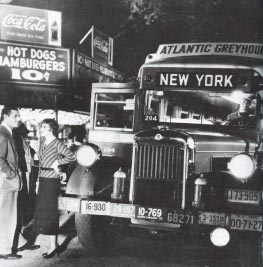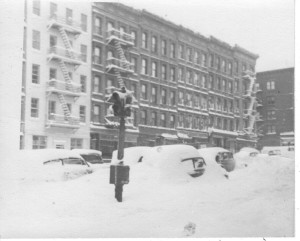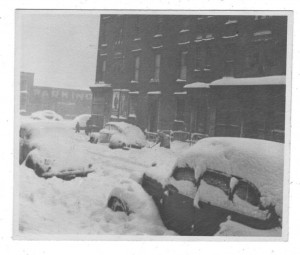On The Schoolbus and Chinese Laundry (NYC ca. 1950)
I am trying to remember the blizzardy winters of the late 1940’s.
In 1949 I was old enough to begin school. On weekdays I rode from my neighborhood called Yorkville on the Eastside of The City to a Westside boy’s school in a big red bus driven by Miss Cawley (sic). The brick-red vehicle was an antique even back then when I rode in it.
Miss Cawley wore heavy work gloves to wheel the bus and pull the crank to lever open the door for me and each young prankster who waited on snowy street corners along her route. She had a weathered face.
She spoke with a brogue and had a confident manly way about her. She was probably average in size.
But, as we clambered aboard she loomed over us, bundled up as she was, from her earflapped fur hat and plaid woolen coat to the boots on her feet. She was no fashion statement but looked ready as any prospector setting out for Yukon gold. She also knew how to drive her bus, which my school chartered from her. Riding up front with Miss Cawley gave me a taste of The City beyond my brief excursions with my mother outside my own neighborhood.
Possibly it was the very same bus Clark Gable and Claudette Colbert rode in to make good their inter-state getaway, eighteen years earlier in Frank Capra’s, It Happened One Night. 
My solo forays into my immediate neighborhood began a year or two earlier when I first trekked down the block as far as the corner, with a paper bag of my father’s soiled white shirts, to the storefront Chinese Laundry on York Avenue. In my other hand I clutched the laundry ticket and enough change to pay for last weeks consignment.
A leafy plant grew from a pot in the window. Otherwise the shop was unadorned. Mr. Lao (not his name) received my bag and quickly matched the number on my ticket to a fresh smelling package of shirts neatly tied with string. He had had them wet washed at a commercial laundry. While still damp he had sprinkled each collar with starch from a bottle, ironed them by hand, folded and wrapped each shirt in a band of colored paper before bundling. I was fascinated when sometimes I found him ironing sheets, tablecloths and other linens. Placing each item on a padded trolley, he would crank it beneath a heated rotating metal cylinder from whose perforated ends I could see blue gas flames hissing and winking. To my mind it was a wonderful machine.
We made a ritual of counting out the coins and making change. In his speech Mr. Lao was brusque and curt as his language seemed to me who understood nothing. But the words were always punctuated with bursts of laughter and a kindness I knew could mean me no harm. I practiced my English on him to no apparent effect.
At the time, I had merely thought how convenient it was that this man lived alone in the back of his small store so near to his work. I knew nothing of quotas and other aspects of immigrant reality, nor the state of Sino-American relations in 1949. That he had had a family was reported to me, only years later while I was away at boarding school. With me away my father had been forced to drop off his own dirty shirts and on one such occasion, Mr. Lao gravely introduced him to Mrs. Lao, only recently arrived from Formosa, who emerged from behind the non-political curtain partitioning off the back of the shop.

It might have been the same International bus that years later became, “FURTHER,” Ken Kesey and The Merry Pranksters’ choice of transport.
Anyway, as Miss Cawley threaded the bus through midtown morning traffic, I gradually grew my awareness of the Greater Metropolitan Area- or at least the Manhattan part of it. I recognized the few familiar landmarks that appeared from this new perspective, looking just as they had from pavement level when seen by my mother and I on our shopping trips. On the bus, one of these trail-markers was the long vertical neon Chop Suey sign outside the one-flight-up restaurant where my mother with her parcels and I used to have luncheon after a morning spent at nearby Bloomingdale’s . Once again, from the bus window I could see the mannequins posed behind the plate glass panes as we passed by.
By the time we had navigated across midtown the bus was almost full of roistering passengers whom Miss Cawley could only slightly subdue by having us sing: The Farmer In The Dell, and Old MacDonald were most popular with these 1st through 4th grade Manhattanites. As we caroled, the bus traversed Central Park South and on into terra incognita. The Westside was as mysterious to me as those areas labeled “unexplored” were to adventurers contemplating the middle of an old map of Africa.
Finally, we reached The School. As we tumbled off the bus, we tried to avoid Miss Cawley’s hands as she tried to tidy up our disheveled appearances. She paid special attention to cowlicks. She didn’t want any of us looking any less than the little gentlemen in her charge that she thought we were.
Looking back, I realize that 1949 was the last year she drove her bus for The School. I had probably witnessed the last of an arrangement necessitated by the wartime manpower shortage. The following year her big red bus was replaced by a chromed silver vehicle with green trim provided by Campus Coach Lines and supplied with a variety of drivers, over time, about whom I remember nothing.
I wonder about the lives of these two individuals, Miss Cawley and Mr. Lao, who affected me in my young years when I was learning a lot and not knowing much of anything else.

